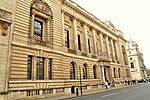Queen Elizabeth II Centre
1986 establishments in EnglandBuildings and structures in the City of WestminsterDepartment for Levelling Up, Housing and CommunitiesExecutive agencies of the United Kingdom governmentExhibition and conference centres in London ... and 5 more
Government buildings completed in 1986Modernist architecture in LondonNational government buildings in LondonTourist attractions in the City of WestminsterTrading funds of the United Kingdom government

The Queen Elizabeth II Centre is a conference facility located in the City of Westminster, London, close to the Parliament of the United Kingdom, One Great George Street, Central Hall Westminster and Parliament Square.
Excerpt from the Wikipedia article Queen Elizabeth II Centre (License: CC BY-SA 3.0, Authors, Images).Queen Elizabeth II Centre
Broad Sanctuary, London Millbank
Geographical coordinates (GPS) Address External links Nearby Places Show on map
Geographical coordinates (GPS)
| Latitude | Longitude |
|---|---|
| N 51.5005 ° | E -0.129 ° |
Address
Queen Elizabeth II Conference Centre
Broad Sanctuary 56
SW1P 3EE London, Millbank
England, United Kingdom
Open on Google Maps





